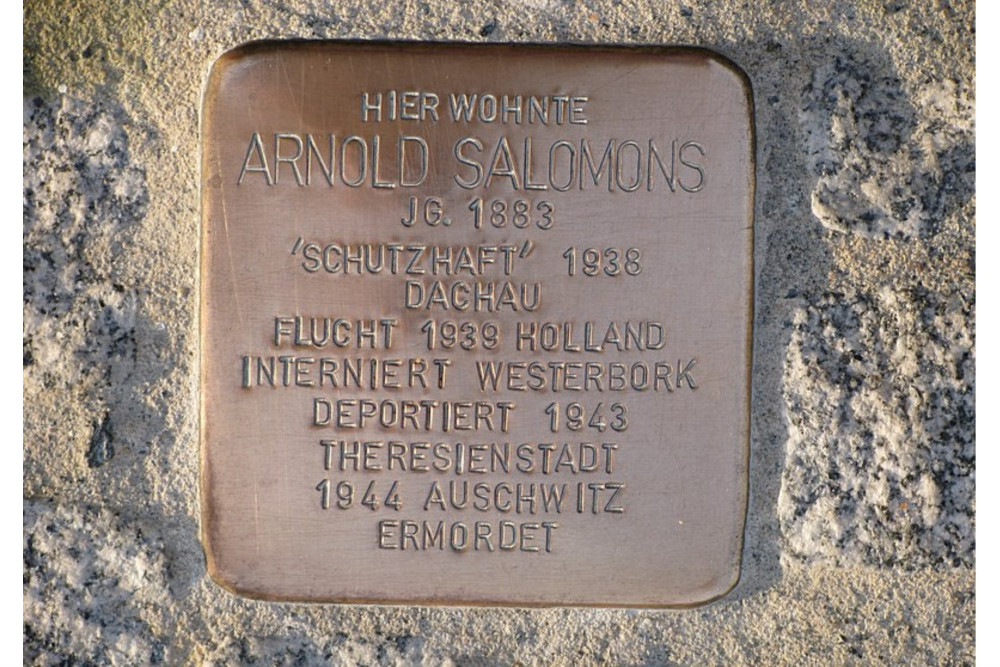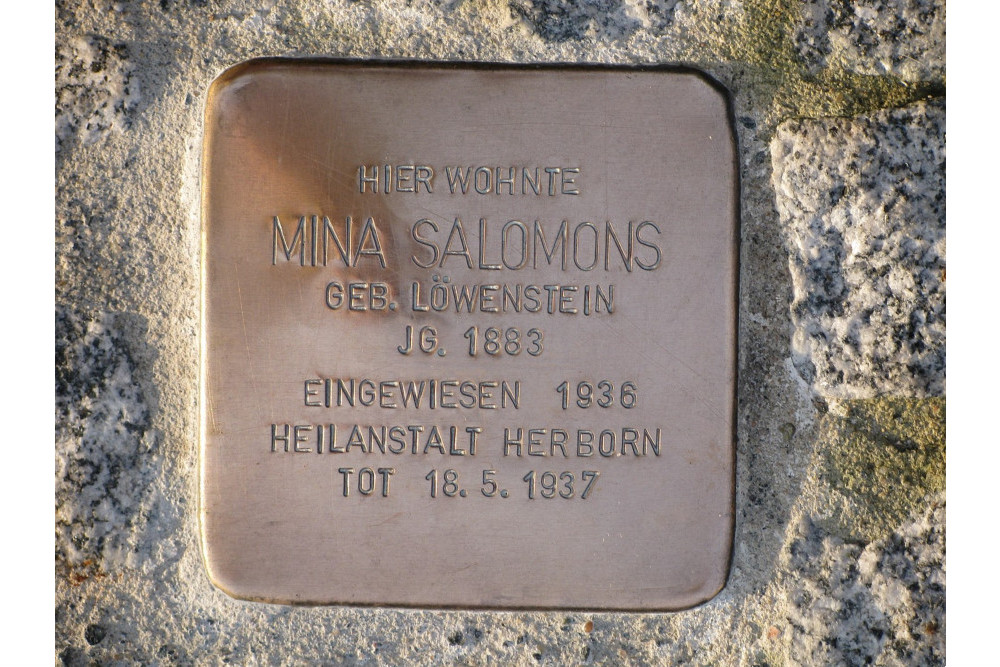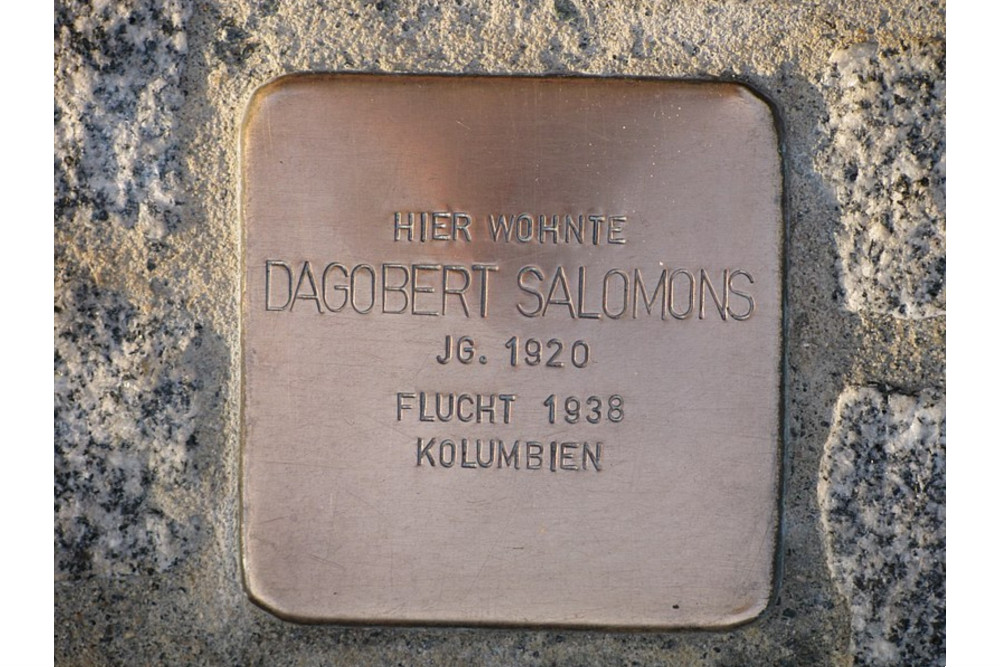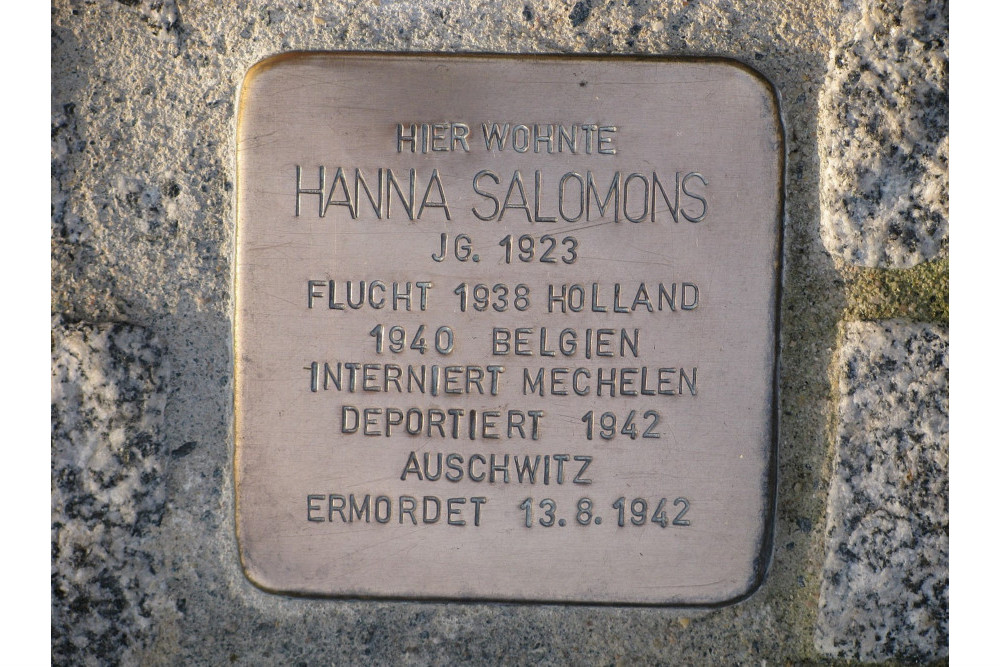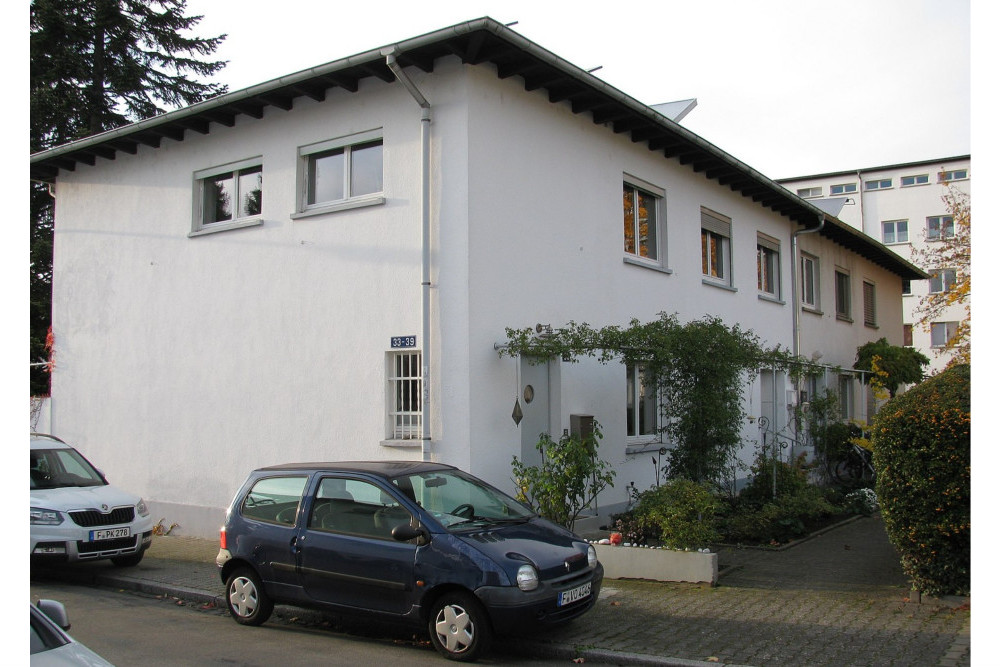Stumbling Stones Karl-Albert-Strasse 33
These small, brass memorial plaques (Stolpersteine or stumbling stones) commemorate:
* Arnold Salomons, born 1883, "protective custody" 1938, Dachau, fled to Holland 1939, interned Westerbork, deported 1943 Theresienstadt, 1944 Auschwitz, murdered.
* Mina Salomons née Löwenstein, born 1883, admitted 1933 Herborn Sanitorium, dead 18 May 1937.
* Dagobert Salomons, born 1920, fled 1938, Colombia.
* Hanna Salomons, born 1923, fled 1938 Holland, 1940 Belgium, interned Mechelen, deported 1942 Auschwitz, murdered 13 August 1942.
Background
Arnold Salomons was the son of a German man and a Dutch woman from Almelo. Arnold was wounded and decorated for his German military service in World War I. In 1919, he and Mina Löwenstein married and made their home in Frankfurt am Main. He worked as a tobacco agent for companies in Germany and the Netherlands. They had two children – Dagobert and Hanna. In 1931, they moved to Karl-Albert Streaase 33, in a new housing estate. With the Nazis’ rise to power came financial difficulties, including that the Salomons had to repay the money they had borrowed to buy their house. Dagobert had to leave school in spring 1936. Mina Salomons became so severely depressed that in the autumn of 1936 she was admitted to the Herborn mental institution, where she died in May 1937. Son Dagobert got an apprenticeship in a company which was forced out of business in 1938. In July daughter Hanna fled to Holland with a business friend to help her attain a professional future. Next, in October the 18-year-old Dagobert fled to Colombia.
When Arnold Salomons returned alone to his house after the November Pogromnacht in November 1938, it had been looted and destroyed. He was then arrested and held in Dachau for two months. After his release, he fled to Holland, meeting a family friend, Lilly Goldschmidt, who had a visa and a ticket to the USA in May 1940. But before she could leave, the Rotterdam harbor from which she was to depart was bombed. She stayed with Arnold Salomons; then both went to Almelo to live with Arnold’s sister Johanna van Coevorden and her family and then with another Dutch-German family. Meanwhile, Hanna lived elsewhere in the NL, where she worked as a nurse for a Dutch family. She tried to escape to Switzerland in 1942 but was arrested in Belgium, deported, and murdered in Auschwitz.
In August 1942, Lilly and Arnold applied for a marriage license in Almelo. The next month they were taken separately to Westerbork, where they met again and married on 6 October. Because Arnold had served his country in WW1, he and Lilly were next deported to Theresienstadt instead of directly to Auschwitz.
Howver, Arnold Salomons was deported to Auschwitz on the last transport from Theresienstadt.
Lilly Goldschmidt survived: she was liberated from Theresienstadt. Stolpersteine for her Goldschmidt family are at Beethovenstraße 60 in Frankfurt.
The Salomons family Stolpersteine, installed on 19 May 2018, were initiated by Rosemarie Reh, resident of Karl-Albert-Straße 33.
For photos and the more detailed story of the Salomons family, visit Frankfurt am Main Stolpersteine page for the Salomons.
"Stolpersteine" is an art project for Europe by Gunter Demnig to commemorate victims of National Socialism (Nazism). Stolpersteine (stumbling stones) are small, 10x10cm brass plaques placed in the pavement in front of the last voluntary residence of (mostly Jewish) victims who were murdered by the Nazis. Each plaque is engraved victim’s with the name, year of birth, and place (mostly a concentration camp) and date of death. By doing this, Gunter Demnig gives an individual memorial to each victim. One stone, one name, one person. He cites the Talmud: "A human being is forgotten only when his or her name is forgotten."
Do you have more information about this location? Inform us!
Source
- Text: Anne Palmer
- Photos: GeorgDerReisende (1), GeorgDerReisende (2), GeorgDerReisende (3), GeorgDerReisende (4), GeorgDerReisende (5)
- Frankfurt am Main Stolpersteine: Salomons family
- Joods Monument
- Stolpersteine.eu
Nearby
Point of interest
- Air-Raid Shelter Friedberger Anlage - Frankfurt am Main
- House Anne Frank - Frankfurt am Main
- Gestapo Headquarters Frankfurt am Main - Frankurt am Main
Monument
- Franco-Prussian War Memorial Frankfurt am Main - Frankfurt am Main
- War Memorial Hauptfriedhof Frankfurt am Main - Frankfurt am Main
- 1864, 1866 and 1870-1871 Wars Memorial Seckbach - Seckbach
Cemetery
- German War Graves Hauptfriedhof Frankfurt - Frankfurt am Main
- Mass Grave Concentration Camp Victims Frankfurt - Frankfurt am Main
- Soviet & Serbian War Graves Hauptfriedhof Frankfurt - Frankfurt am Main
